Yet somehow, many high school and middle school electrostatics labs have been relegated to simple exercises like rubbing balloons through your hair and moving bits of tissues paper with charged combs. So here, I'd like to supercharge some of these ideas and introduce some opportunities for more science, measurement, and innovation around the topic.
Electrostatic Simulations
Let's start with just trying to "see" and understand what is going on in simple electrical situations with charges and fields and voltages, etc. Chalkboard drawings are just so antiquated. Instead, start by playing with these three online simulations by clicking on the links or pictures below.
A 2-dimensional Electrostatics Applet. This one lets you move charges around and plots fields, potential difference (Voltage), equipotential lines. etc. as things move around. The picture above shows the fields, potential, and charge for a quadrupole (two positive and two negative charges).
A 3D Electric Field visualization applet for 2D charge distributions. This picture shows the electric field strength (in the z axis) of a simple dipole (one positive and one negative charge)._
A 3-dimensional Electrostatic Field Applet that let's you look at the fields that result from interesting 3-D charge distributions and simple current configurations. The picture above shows a couple of simple wire loops with current running in opposite directions.
When you get the point that you think you understand what is going on and how to visualize it, try playing this game of Electric Field Hockey and see how you do! You have to place charges on the field to make the puck respond the field generated by your placed charges in order to navigate the boundaries into the goal! Click on the picture or link below to play.
Electrostatics in the Real World
Now that you've fiddled with a few spiffy simulations on the computer to begin to get a feel for electrostatics, now how do we translate these ideas to the real world? If I was really old-school, I'd suggest starting by making a simple electroscope and electrophorus with some thin metal foil. Yawn.
(Speaking of old-school, though, this is one of my favorite Electrostatic demos, by Prof. Lewin at MIT demonstrating the magic of cat fur. I've seen it in person, where the flash effect is much more obvious than in the low frame rate video. It's the deadpan theater aspect that really does it for me.)
Okay, yes, cat fur and Styrofoam are really old-school, though evidently fun when properly wielded. But there are a couple of more modern variations like the PVC Pipe Static generator that work REALLY well,
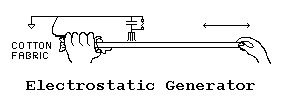
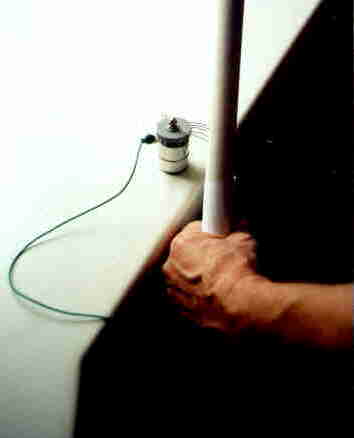
And a nice Leyden Jar type Capacitor made out of a film can that you can use to store charge.
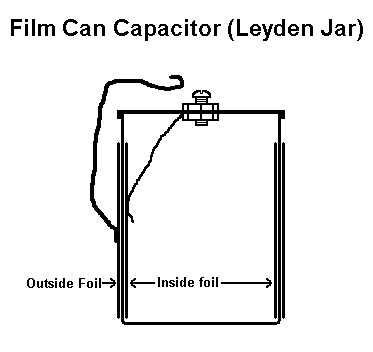
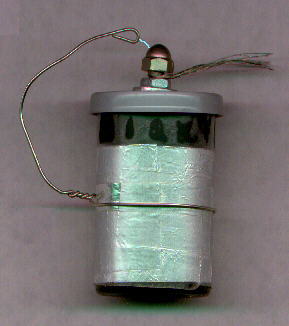
If that stuff works for you, here is a GREAT web site with all sorts of static machinery that's easy for the aspiring scientist to build, called "Electric Blue Sparks." One of my favorites was entitled the "I have to make really big sparks at the science fair tomorrow" link.
Or how about making a real-life 3-D electric field viewer? (easier than it sounds-the whole thing is doable in about 5 minutes start-to-finish) Try this variation on the traditional magnetic field viewer (simply 1/16th inch slivers of 0000 (ultra-fine) steel wool suspended in baby oil. To see electric fields instead, just substitute 1/16th inch slivers of one of your classmate's black hair. Bonus points to any student who can explain how or why this works. See William Beaty's site for details including a video example.
Better yet, if you'd like to use some of this last century's technology, how about making a REALLY sensitive electronic electrometer? The circuit couldn't be simpler. (Also from William Beaty's Web site!)
Neither the earth-ground nor the 1 MOhm resistor are required. You can change the gain (sensitivity) of the detector by changing the value of the resistor, and either shortening or lengthening the antenna.
In contrast to the foil-variety electrometers, this sucker is sensitive enough to detect someone combing their hair at a distance of 5 meters or more (if your antenna is around 1/2 a meter long, and the humidity is low.)
Try building one, and then devising experiments to see and measure how little charge (voltage) the sensor can detect. You'll be surprised, I promise!
PARTS LIST:
- 1 - Standard 9-volt battery
- 1 - MPF-102 N-channel Field Effect Transistor (FET) Radio Shack #276-2062
- 1 - any Red Light Emitting Diode (LED), eg Radio Shack #276-041
- MISC:
- Battery connector (#270-325)
- Alligator Clip Leads (#278-1156)
- solder, if desired
- 1-meg resistor (not required)
- plastic, fur, foil, comb, tape dispenser, plastic cup
Further, William has some great experimental suggestions once you've built your very own, and includes a section on how the circuit works:
- 1. SENSE E-FIELDS
- 2. SENSE POSITIVE ELECTRIFICATION
- 3. ELECTRIC CHARGE IS CONSERVED
- 4. PEELING CAUSES ELECTRIFICATION
- 5. JUMPING ELECTRONS, "VOICE CONTROL"
- 6. VARIABLE GAIN
- 7. FIELD DISTORTIONS
- 8. VANDEGRAAFF SENSING
- 9. HOMEMADE CAPACITORS
- 10. DIPOLE ANTENNA
- 11. THE SKY VOLTAGE
- 12. BATTERY VOLTAGE
- 13. UNTESTED SUGGESTIONS
If you found that easy and/or interesting, try building this simple Marx Generator that only needs a few dollars-worth of parts.

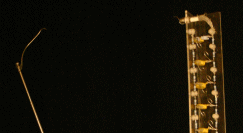
Here are some other simple activities to show electric effects from surface contact other than with friction using Scotch tape. Oh yes, and some plans to build your own Van de Graaff Generator.
For something REALLY cool and esoteric, how about recreating an electrostatic generator from dripping water, a. la. Lord Kelvin, or a souped-up multi-stage version? All you need are some aluminum bundt pans, fishing line, and a couple aluminum buckets.
This is a short video of MIT's Professor Walter Lewin showing the "water droplet battery" in action.
Can anyone tell me how this works?
If you're looking for a good reference book with lots of interesting projects, try the Electrostatics Handbook, by Charles Green.
Finally, if you're interested in the history, check out the SparkMuseum to see some of the actual original scientific and demonstration equipment from when people were first figuring this stuff out.




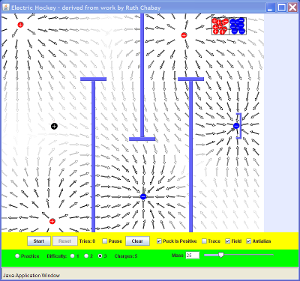
![[SCHEMATIC OF DEVICE]](http://amasci.com/electrom/e-field2.gif)
![[Drawing: FET and LED soldered to 9v connector]](http://amasci.com/emotor/fetdet1.gif)
